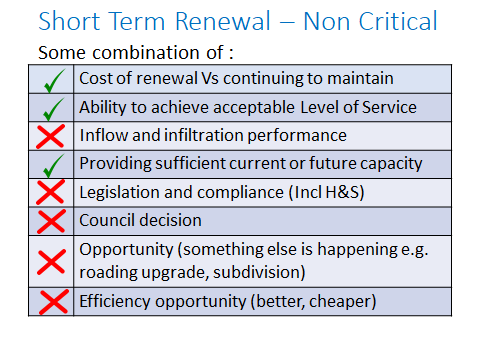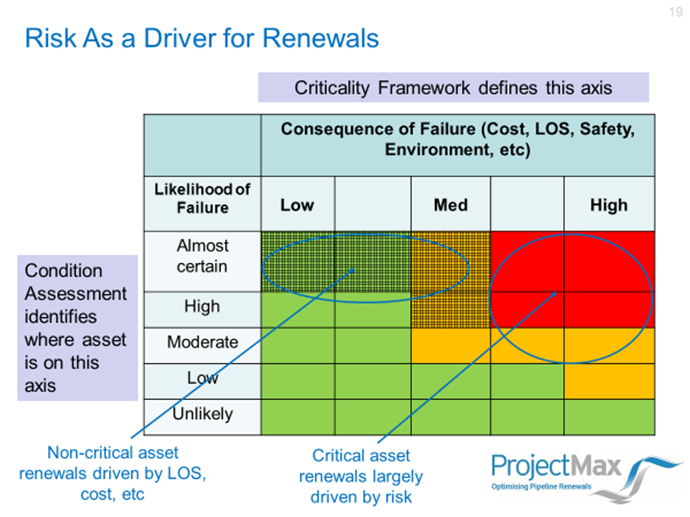Short Term Planning – Non-Critical Assets
Introduction – Drivers of Short Term Planning
Short term planning is focused on the actual works that will be undertaken in the near future and the specific allocation of funding for this. This makes it quite different from long-term planning focused on the big picture and the trends.
In our view, each of the short-term renewal projects proposed, particularly for the 1-3 year programmes, should be justified by reference to one or more of the following Drivers. These drivers may actually require the early renewal of an asset that has useful remaining life, which may have financial implications with the ‘write-off’ of value.
In many cases, the overall driver of the project may be a combination of many of these drivers. The asset may need renewal, but it will be made larger, perhaps providing a higher service level and improving the overall resilience. The opportunity might also arise to relocate the asset.
Risk is included in this list, but this will usually relate only to assets with elevated criticality. By definition, a non-critical asset has insignificant consequences of failure and will be a low risk even when failures are virtually certain to occur.
Renewal of Non-Critical Assets
Every renewal of a non-critical asset proposed for the short term should have a specific driver and justification for the works and evidence to support that. The justification will typically be included in the following table (the ticks and crosses are just illustrations of the justification that might apply to a particular proposal).
Reaching the end of its expected life and/or having a $0 depreciated value is not, in our view, sufficient justification for renewal and the pipe should remain in service until a clear justification emerges.
Identification of the need for renewal would come from records of maintenance works, interviews with the maintenance contractor, references to hydraulic modelling, etc. The list of assets included in any backlog emerging from the long term planning is a useful place to look for renewal candidates but is not a justification in itself.

If the short term planning needs to cover more than a single year, it is unlikely that there will be sufficient specific assets identified to populate the expected programme of works. However, it is expected that evidence to justify future renewals will emerge during this period and provision, therefore, needs to be made for these emerging works.
The solution to this situation is to build up the programme in 2 parts:
- Identify specific assets that need to be renewed and which already have clearly defined justification for doing so. There may be reasons for spreading these works across the short term planning period.
- Add provision for the works that are considered likely to emerge during this period. This will not relate to specific assets and is purely a budgetary provision. The magnitude of this provision will be guided by the extent of works undertaken in recent years and the extent of works indicated by the near end of the long term planning described above. All parties should clearly understand that this funding will only be utilised if clear justifications for the specific renewals are identified. It should also be recognised that this provision might be inadequate for all the justifications that do emerge. In this situation, the provider will need to decide whether to allocate additional funds or push the works out into the next planning period.
Stretching and Smoothing the Renewal Programme
The emphasis in the above discussion is very much on evidence and justification before renewal is undertaken.
If this is applied as the sole criteria for renewals to proceed, this may result in a somewhat spikey programme wherein there are potentially quiet years when few assets need renewal and busy years following. This can be undesirable in relation to maintaining a steady flow of work through the investigation and design phases, maintaining project management capability and providing a steady flow of work to suppliers and contractors. It can also be considered to be undesirable from a funding perspective.
It can be desirable to include a ‘near enough’ category into the renewal programme to provide a smoother workflow. This would include assets whose performance does not breach the level of service standards but are clearly on a path to that situation. It might also include assets deemed to be very similar to those that do have an evidence base that justifies renewal or assets that logically should be replaced at the same time as a more clearly justified renewal. These assets might have otherwise given a few more years of acceptable service, but it is acknowledged that they have consumed most of their life expectancy and the benefits of stretching the renewal programme outweigh the loss of value. Again this is a discussion that can be logically shared with the financial arm of the organisation to ensure there is a shared understanding of how renewal projects have made it onto the list.
Short Term Planning - Critical Assets
Introduction
This quadrant shares some of the features of the short term planning for non-critical assets.
It is focused on identifying the actual works to be included in the renewal programme, focusing on evidence.
The difference is that it is focused on evidence that indicates that the asset has reached an unacceptable level of risk, even if it has not failed, rather than the evidence of actual shortfalls in performance and reliability. Consideration would be given to the drivers described on the non-critical renewal discussion, but primarily the focus is on risk.
These are the assets that the provider does not want to suffer failures as the consequences are all worse than the insignificant status afforded to non-critical assets. A provider might allow for limited failures of assets with moderate criticality but could manage this risk with a process to fast-track a renewal before it occurs again.
The process should logically start with a review of the assets with high criticality on an asset by asset basis. This would consider what information is known, how much confidence the provider has in that information, whether the criticality ranking is still valid, and where the asset now sits in the risk matrix.

The evidence that would be considered would include any available condition information, the performance of similar assets, emerging concerns from the industry etc.
This assessment allows the asset to be placed on the risk matrix and an assessment made about the need to progress a replacement in the short term. As many of the assets with elevated criticality are large trunkmains or in difficult locations, the costs may be high. A specific and detailed business case may be necessary to justify renewal to senior management, governing bodies and customers. However, if the overall process has been followed for several years, the need to replace a critical asset should have been signalled for some time.
Once it is determined that an elevated criticality asset should be on the short term renewal programme, this project should prioritise all non-critical renewals. It is not anticipated that numerous critical renewals would surface in any planning year. If this arose and funding was constrained, then the priority between assets would be determined based on a detailed assessment of the relative likelihood, consequences, and risks associated with each asset and an informed decision.